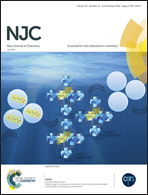A convenient method for isolating carbon quantum dots in high yield as an alternative to the dialysis process and the fabrication of a full-band UV blocking polymer film†
Abstract
We introduce a facile and convenient method to isolate more than 80% carbon quantum dots (CQD), for the first time. The proposed method substitutes a lengthy conventional dialysis process. An organic solvent, n-butanol is used to extract CQD in a high yield with the cumulative particle size distribution at 2.6 nm. The polymer films were fabricated as a function of increasing content of CQD, and shielded full-band UV light. It is found that the presence of surface functional groups in the CQD creates a high level of dispersion in the polymer matrix and it can block >99% of UV light with just 10 mg of CQD. A plausible mechanism is proposed to explain the superior UV shielding properties of the polymer film and is confirmed by protection of a photo-degradable model dye. Due to being non-toxic and environmentally friendly, the CQD dispersed polymer film could be a promising material in the food packaging industry to protect UV sensitive foods.



 Please wait while we load your content...
Please wait while we load your content...